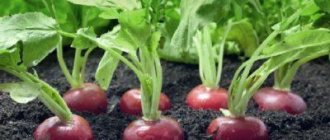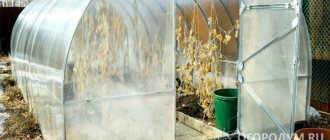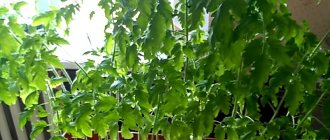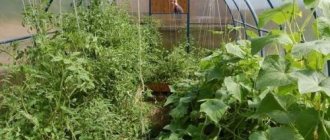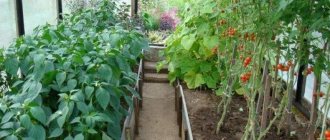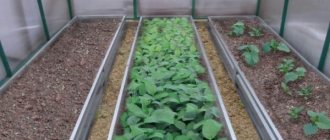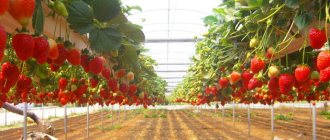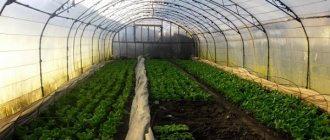When you have a heated greenhouse at your disposal, you are lucky: you can have a garden and fresh vegetables and herbs on the table literally all year round, receiving several harvests during this period. Any vegetable can be grown, any crop can grow. In this article we will tell you how to prepare such a structure and what can be planted there.
What a heated greenhouse should be like 2. Planting dates 3. Planting onions 4. Conditions for salad 5. Growing dill 6. Growing parsley 7. Growing tomatoes 8. Cucumber seedlings 9. Eggplants 10. Growing bell peppers
Photo: Any crop can be grown in a heated greenhouse.
Description of the structure
- A heated greenhouse is a permanent structure that must have a foundation. It must withstand both wind and significant snow loads.
- This can be a stand-alone structure or an extension to an existing structure, for example, to a utility block.
- When building, pay special attention to the foundation; it needs to be deepened by about a meter and be sure to be additionally insulated from the outside.
- Place the structure exclusively in an open area so that it receives as much sunlight as possible.
- The optimal shelter is polycarbonate. Film and glass are a thing of the past.
Photo: The greenhouse must have reliable heating.
- There should be the most reliable heating system possible. It can be watery, eclectic or airy. The structure must be equipped with a ventilation system and have an irrigation system - ideally, this is reliable and economical drip irrigation.
- You cannot do without placing additional lighting, which dramatically increases the length of daylight hours.
- The soil in a winter greenhouse should be as nutritious as possible. You can build both warm beds (especially if you live in a cold region and the greenhouse is not equipped with a soil heating system), and ordinary beds, but consisting of a mixture of humus, river sand and nutritious soil from the garden.
- The temperature at night should not fall below +15 degrees, and during the day it must be possible to increase it to +25.
Kinds
Theoretically, a greenhouse is a heated, illuminated structure equipped with an artificial irrigation system and having large dimensions. The greenhouse , on the contrary, has a more modest size and is not heated or lit. In practice, a greenhouse differs from a greenhouse only in size.
Today there is a wide selection of greenhouses of different designs, sizes and materials.
build a greenhouse with your own hands using available materials. Greenhouse structures are shaped like arched, hipped, polygonal, wall-mounted and gable.
They must be mounted either on a pre-prepared foundation (which significantly increases their service life) or directly into the ground.
There are also hydroponic greenhouses.
It would be more appropriate to install the greenhouse on the south side of the site.
This will further protect the building from wind wasps and the plants will have enough natural sunlight . Materials include glass, polyethylene, polymer films, spunbond, and polycarbonate.
From glass
A glass greenhouse has very high light transmittance and thermal insulation properties. Durability is a huge plus of this material. However, fragile glass can crack, and during the hot season, the temperature inside the greenhouse can reach unfavorably high temperatures, which is not very good for growing crops in greenhouses.
From film
Polymer film is a lightweight option that can be used without a foundation, which allows you to save time and move the greenhouse to a convenient location. The light under the material is evenly dispersed, which is an advantage of this structure.
However, wear resistance leaves much to be desired. The formation of internal condensation also plays an unpleasant role for growing plants in a greenhouse.
Polycarbonate
Early planting in a polycarbonate greenhouse:
Polycarbonate combines the best properties of glass and film at the same time. It is distinguished by its high transmittance of sunlight, which is evenly dispersed inside the structure. Has high heat-insulating properties .
Wear resistance here is also at the same level, and the increased flexibility of polycarbonate sheets allows you to install such greenhouses on a plot of land without much effort.
The structure of the installed structure can be either simple or complex, and the dimensions can also vary. From cellular polycarbonate, it is possible to build both a small greenhouse for seedlings and a huge greenhouse for growing fruit and vegetable crops and flowers. What can you grow in polycarbonate greenhouse Everything described above. You can see in the photo below what to plant in the greenhouse.
Growing in a greenhouse - photo:
Now you know what is grown in polycarbonate . But very often greenhouses are used as a business . How? Consider below:
When to plant in a greenhouse
Typically, heated greenhouses can operate year-round. Immediately after harvesting the previous crop, replacing, cleaning or disinfecting the soil, applying appropriate fertilizers, and carrying out all sanitary and preventive measures, you can plant new seedlings or continue cultivating the previous crop by planting new plants and continue to receive a harvest.
Photo: In such a structure you can plant anything, even grapes.
| Important. You need to be sure that you can maintain lighting in the winter greenhouse, provide watering and a temperature of at least 15 degrees Celsius. |
The structure allows you to cultivate anything, even grapes. However, vegetable growers often give preference to crops that do not require too much attention and care.
Vesya, grapevine
Do you want wine, or will you eat like this? Juicy, ripe grapes in Siberia ripen only and exclusively in a greenhouse. In open ground it grows much further south, and here you can freely plant only ornamental vines, from which no fruit is expected. But closed soil gives the opportunity to get not only a fruit-bearing, but also a very aesthetic “plantation”. The grape leaves are so cute!
But remember that grapes are a kind of VIP. Often, in one greenhouse, thrifty summer residents manage to grow several different crops at once. Yes, only this lover of comfort, when it grows, will cover the whole light of its short neighbors with its leaves. But there is no point in growing an equally large competitor next to grapes - it is better to set aside a separate room for pouring delicious bunches.
Also, do not confuse table and wine varieties. Of course, you can eat “wine” grapes just like that, and use table berries to make an alcoholic drink. And no one will get poisoned (just kidding). But still, it’s not for nothing that breeders carefully bred them - each variety “plays its role” more successfully than someone else’s.
Onions on greens
For these purposes, you need to use those types of onions that have a minimum biological dormancy time. During the cold period, such onions as multi-tiered, batun, chives (skoroda) and slime are suitable for growing in a winter greenhouse.
Onions are not a particularly demanding plant. It grows well in a mixture of standard garden soil and peat. It needs nitrogen fertilizers for growth and development.
Photo: Growing onions.
Typically, the onions are cut to the shoulders and soaked in water at a temperature of +30 degrees for about a quarter of an hour, then planted in the ground.
About 12–14 degrees of heat should be maintained in the greenhouse for about seven days. At night you can leave the same temperature, and during the day raise it to +17...+19 degrees. Water only when the soil dries out. Daylight hours should be 9–10 hours; it is ideal to use phytolamps for this.
After a month, we remove the greens.
Not just for the stomach
But why are we talking only about food plants? How could we forget about ornamental crops? Among them there are also quite delicate ones, requiring greenhouse conditions for growth and lush flowering. The greenhouse can be turned into almost a real greenhouse.
Almost, because a greenhouse is a more complex and expensive structure - and, even more so, a winter garden takes a big toll on your pocket. But, as they say, “nobody forbade growing flowers in an ordinary greenhouse.” You can arrange them so that every visit to the “green house” turns into a small holiday.
In general, the capabilities of greenhouses are such that it is technically impossible to list them all in one article. The complete list will not fit on the page! And, by and large, only your imagination and skill determine what crops can grow on the hacienda. Finance? A home craftsman with golden hands is able, not in 100% of cases, but very often, to replace a costly solution with a “cunning” one, and it will be better than a store-bought one!
Go for it. Let the greenhouse make you happy.
Growing lettuce
The salad is very unpretentious and is excellent for cultivation in a winter greenhouse. What it needs: plenty of moisture, lighting 8–9 hours a day, and a temperature of about +15 degrees. Every 20 days you can harvest.
Watercress is ideal.
Photo: Lettuce does well in warm conditions.
In addition to lettuce, a heated structure in winter will allow crops such as rhubarb, chicory, chard and even asparagus to thrive. Plants need no more light than lettuce. The main thing is to cut off the largest leaves located on the periphery during the harvesting process.
We want watermelons! We wish you melons!
A small harvest of Siberian watermelons or collective farm melons can also be obtained under temporary film cover. But, if you are a true fan of melons, if you need more and larger ones, you will have to build a greenhouse. Then your dessert will definitely not be dependent on the whimsical vagaries of the weather.
With a certain skill, you can grow watermelons or melons before the first large-scale “layer” appears in bazaars and stores. Can you imagine the envy of your neighbors? They haven’t tried watermelons or melons yet! In such a situation, it will be pleasant, and from a diplomatic point of view, useful, not to force people to lick their lips, but to share a melon or two. Look, in a year they will build a greenhouse?
There are people who grow vegetables not for themselves, but for sale. This is more difficult - after all, you need to understand not only the intricacies of agricultural technology of crops, but also ingenious and complex laws, and have a business sense. If you are not afraid of the elements of the market, it seems to me that growing the very first melons can bring a good income.
Dill cultivation
It is cold-resistant, shade-tolerant, and not picky about the soil. It is better to take early varieties for cultivation in a building, such as Richelieu, Redut, Gribovsky, Dalniy, Grenadier and the like. Want to get your greens in as quickly as possible? Sow already sprouted seeds, placing the seed in furrows about 2 cm deep.
If there is more than enough space in the building, then dill can be planted separately. If the space is close, you can plant it among onions or lettuce.
The most delicious dill will be obtained on loose, moist soil at a temperature of about +15 degrees and eight hours of daylight.
Photo: If there is a lot of space, then dill can be planted separately.
While there are no seedlings on the soil surface, be sure to moisten the soil, then watering will be necessary about once a week.
Usually 30 days after sowing it will be possible to harvest the first harvest of dill. If you want the greens to grow actively and there is a lot of it, then add dissolved ammonium nitrate in an amount of 10 g per bucket of water. This is the norm for 5 square meters of bed.
Permissions to open
For this type of activity, the seedling seller must obtain sanitary phytocertification. You can get it from the sanitary inspection. It is also necessary to register the enterprise with government authorities, register with the tax office as an agricultural producer, purchase land or enter into a lease agreement. In fact, there are still a huge number of ways to get rich. The author of this blog writes in great detail about these methods in an article about methods of investing and starting a business.
( 17 ratings, average: 4.00 out of 5)
Loading…
Similar business ideas:
- The best business ideas for a village
- TOP 30 business ideas with minimal investment
- Growing tobacco for sale as a business
- TOP 30 business ideas without investment
Growing parsley
It is optimal to grow parsley from seeds, and sprouted seeds. Sow the seeds in grooves about 2 cm deep, then sprinkle them with a little soil and water the soil.
| Important. For normal growth, parsley needs a temperature of 13 to 17 degrees Celsius. The main thing is not higher, otherwise the leaves will begin to turn yellow. Do not over-moisten the soil, water it only as needed. |
The first harvest can be harvested as soon as the seedlings reach a height of 12–14 cm. If you want to increase the yield several times, you can feed the plants with urea at a dose of 15 g.
Photo: Parsley needs a temperature of 13 to 17 degrees Celsius for normal growth.
In addition to greens, you can grow other crops by initially growing seedlings there.
Tax system
This business relates to the production of agricultural products, therefore a taxation system for agricultural producers, the so-called single agricultural tax, is applied. (ESKHN). The main condition of this tax is that the revenue from the sale of these products is at least 70% of the total revenue, and also that the enterprise must be engaged in the production of agricultural products, and not in their sale. The Unified Agricultural Tax is calculated as follows: StxB, where St is the tax rate, B is the tax base. The tax rate is 6%, and the tax base is calculated from income received in the reporting period, minus expenses.
Professional business plans on the topic:
- Farm business plan (45 sheets) - DOWNLOAD ⬇
- Plant nursery business plan (25 sheets) - DOWNLOAD ⬇
- Business plan for growing potatoes (15 sheets) - DOWNLOAD ⬇
Tomatoes
Usually from December 1 to 5, you can sow tomato seeds in a winter greenhouse to obtain seedlings.
Sowing is carried out in boxes with previously prepared nutrient soil. Then they are well watered and covered with film until shoots emerge (usually one week).
Tomato seedlings require regular watering with water at room temperature and additional lighting for at least 12–14 hours.
For tomatoes, you need to maintain a temperature of 24 to 26 degrees during the day, and at night - from 14 to 16 degrees. From the moment the shoots emerge, lower it to +14...+19 degrees during the day.
When the cotyledons are formed, it is necessary to pick out the seedlings, and then feed the plants with complex fertilizer - nitroammophos - in the amount of a teaspoon per bucket of water.
Photo: Tomato seedlings require regular watering with water at room temperature.
After 14–19 days, it is necessary to re-feed (a teaspoon of superphosphate and potassium sulfate per bucket of water).
In the last month of winter, the seedlings will be ready for planting in the beds. After this, you need to water the tomatoes not leaf by leaf, remove the shoots, and as soon as the plants reach their full growth, you need to pinch the top.
Lighting should be set at least 12 hours a day. The temperature during the day is from 21 to 23, at night - from 17 to 18 degrees.
F1 hybrids are perfect for cultivation in a winter greenhouse: Vasilevna, Divo, Evpator and Dorbun.
Where to begin
You should start running a business by developing a business plan. It includes the following sections:
- assessment of the market situation, analysis of competitors' activities. It is necessary to find out what exactly other producers grow, in what quantities, where they sell the finished products;
- choosing a product to grow. After this, you can determine the specific area for crops, type of fertilizing, method of care, etc.;
- choosing the type of greenhouse;
- determining methods of marketing finished products;
- calculation of investments and income. This will allow you to determine how much money you need to invest and how long it will take for the expenses to pay off;
- searching for sources of additional funding.
Attention! To start running a greenhouse business, you need at least minimal experience in growing plants. Without this, it is impossible to earn income from running your own business.
Greenhouse business is one of the forms of earning money
Cultivation of cucumbers
Usually, for the sake of seedlings, cucumbers are planted in a greenhouse from the beginning of January. It is necessary to sow seeds in a container with pre-prepared nutrient soil. Afterwards, they need to be covered with film for 4–6 days until shoots appear, providing additional illumination for at least 10 hours a day.
Cucumber seedlings grow best at temperatures of 22–24 degrees during the day and 17–19 degrees at night. From the moment the seedlings appear, it needs to be lowered to 16-19 degrees for a week, then returned to the previous level.
Photo: Usually, for the sake of seedlings, cucumbers are planted in a greenhouse from the beginning of January.
It is better to feed cucumbers twice - with complex fertilizer (nitroammophos). The first time - as soon as two true leaves form (a teaspoon per bucket of water) and the second time - after 12 days (5 g of potassium sulfate, 15 g of nitrogen fertilizer and 25 g of superphosphate per bucket of water).
In February, plant the plants in a permanent place in the beds, making sure to retreat 45 cm from one plant to another. The seedlings need to be buried down to the cotyledon leaves.
Cucumbers need careful watering; the soil must be kept loose.
Lighting should be maintained for 11–13 hours per day. The temperature is approximately 23 degrees above zero during the day and 20 at night.
For cultivation, it is better to use F1 cucumber hybrids: Tamerlan, Makar, Emelya, Mastak.
Interesting
Only in a greenhouse can you grow chayote, an exotic guest from Latin America nicknamed the “Mexican cucumber.” Translated into Russian from the Aztec language, its name means “pumpkin covered with thorns.” These pear-shaped green fruits look like an avocado and taste like zucchini.
It would seem, why such an innovation? After all, we already have zucchini. However, chayote is unique in that it is absolutely edible. The entire plant, including tubers and young shoots, is eaten. This is efficient use of space! And its fruits can be stored for up to eight months.
Blue ones
Eggplants also work quite well. They can be sown for seedlings already in early February.
It is better to sow seed material in boxes where the soil is nutritious and moist. Moisten and cover with film until shoots emerge (about a couple of weeks). You need to provide additional lighting 12 hours a day.
Warmth until the seeds germinate should be maintained at 21–24 degrees during the day and 13–14 at night, and a week after germination, for 5–6 days the temperature should be lowered to 16–19 degrees above zero.
The little blue ones usually do not dive; in the phase of a pair of true leaves, they can be transferred to larger containers without damaging the roots. After a couple of weeks, feed them in the same way as cucumbers.
Photo: Eggplant seedlings can be sown as early as early February.
Prepare a permanent place for eggplant seedlings in April, remembering to water them regularly and loosen the soil. The main stem is usually attached to a trellis, and the crown is pinched.
Daylight should be maintained for 12–16 hours a day, heat should be kept at 15–16 degrees at night and 17–18 during the day.
Eggplant varieties for cultivation in a greenhouse are F1 hybrids: Balagur, Behemoth, Lolita, Maksik and the like.
How much can you earn
In this type of business, it is difficult to calculate income, since some individual entrepreneurs already have greenhouses, while others will make investments in their construction, and income also depends on the size of the greenhouse. A sample business plan would look like this. To grow seedlings you need:
- Greenhouse (film or made of polycarbonate), area 18 sq.m. If you grow seedlings in two tiered boxes, then the usable area doubles and is 36 sq.m. This area yields 7,500 cups of seedlings. The cost of one cup of seedlings ranges from 8 to 15 rubles, depending on the region. Thus, 7,500 glasses of at least 8 rubles will bring an income of 60,000 rubles.
- Purchase of varietal seeds and bulbs with a germination rate of up to 80%. The cost of one seed is approximately 12 kopecks per piece. For growing 7,500 pcs. 9,000 seedlings need to be purchased. seeds, 1,080 rubles will be spent on this.
- Purchase of soil for cups, approximately 10 cubic meters. will be 8,000 rubles.
- The cost of 1 glass is 1.8 rubles, in total you will need 13,500 rubles.
- Heating a greenhouse during the period of seedling growth will cost 2,000 rubles.
Total expenses will be: 1,080+8,000+13,500+2,000= 24,580 rubles. Net profit will be 35,420 rubles. (For more details, read the article “Greenhouse Business Plan”) Which OKVED should you indicate for the purpose of registering OKVED 2 Section A: agriculture, forestry, fishing and fish farming. OKVED 2 01 Plant and animal husbandry, hunting and the provision of related services in these areas. OKVED 2 01.3 Growing seedlings OKVED 2 01.30 Growing seedlings
Pepper and eggplant
You can grow wonderful peppers in a greenhouse. If the structure is not heated, then different varieties grow in it; you can grow hybrid versions of medium-sized and tall bell peppers, which produce large or medium-sized fruits.
You can form a bush of medium-fruited and large-fruited peppers in different ways. In temperate climates, weather conditions vary during the summer months. If you form bushes in the same way in an unheated greenhouse, then large-fruited plants will be overloaded. After this, they shed the ovaries, and the buds fall off at the tops of the shoots.
Form a medium-sized pepper so that 2 stems remain. At the point where the stem branches, the most powerful shoot is left. The other shoot is pinched, 1 leaf remains on it, and the shoots are removed. If the pepper fruits are large, there should be 1 shoot left.
The growing conditions for peppers must be suitable to prevent sunburn on the leaves.
Berries
The smartest way for lovers of fresh berries to occupy greenhouse space is to plant wild strawberries. Here, these berries are guaranteed to ripen and produce a bountiful harvest without the risk of damage by numerous pests that lie in wait for them in the open air. In addition, you will harvest not just once, but twice or even three times. The best varieties of greenhouse strawberries are “Marmalade”, “Zephyr”, “Pineapple”. You can also try growing sweet raspberries - unpretentious varieties “Ruby Necklace”, “Hercules”, “Orange Miracle” have been specially bred for greenhouses. Particularly enthusiastic gardeners have long been growing blueberries and blueberries in greenhouses.
Required Documentation
Legal registration of greenhouse business – legalization of production. To register your own business, you need to decide on the type of business object:
- individual entrepreneurship. This form is recommended if large production volumes and a wide distribution line are planned. In this case, a certificate of conformity is required, which is given to the individual entrepreneur;
- peasant farming. This form is chosen if you plan to do business with other participants. Polyus Peasant Farm – the opportunity to participate in government programs;
- personal subsidiary plot. Suitable for owners and tenants of plots up to 2 hectares.
Each form will require a specific package of documents, which are presented on the official website of the tax office. After preparing the kit, it must be taken to the MFC. If there are no complaints about the documents, after a certain period of time you can pick up the finished certificate. The exact deadline will be announced at the MFC after the package is accepted.
Initial capital
To organize a business, you need start-up capital. Its amount depends on several factors:
- the amount of available funds;
- type of greenhouse, crop;
- scale of production.
Before investing, you need to calculate the amount of expected profit and the time when the contributions will pay off. It's best to start with small financial investments. Gradually, the business can be expanded if it brings good, stable income.
The greenhouse business can be expanded if it brings good, stable income
